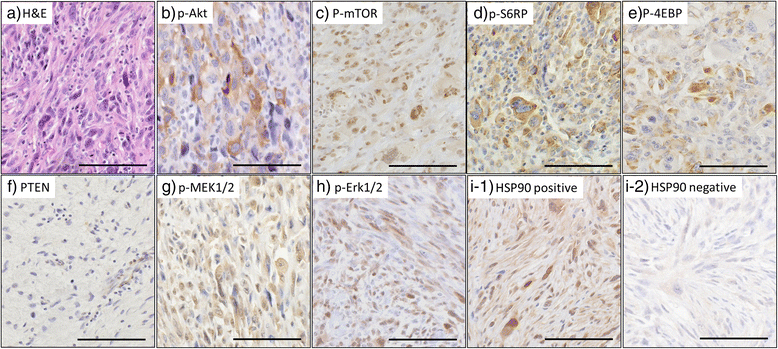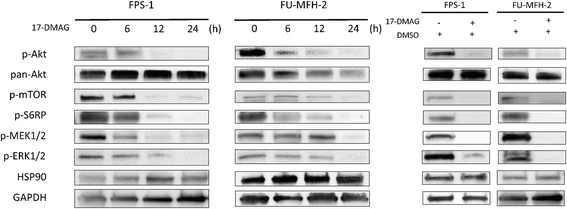Elevated expression of HSP90 and the antitumor effect of an HSP90 inhibitor via inactivation of the Akt/mTOR pathway in undifferentiated pleomorphic sarcoma
- PMID: 26502919
- PMCID: PMC4623920
- DOI: 10.1186/s12885-015-1830-8
Elevated expression of HSP90 and the antitumor effect of an HSP90 inhibitor via inactivation of the Akt/mTOR pathway in undifferentiated pleomorphic sarcoma
Abstract
Background: Undifferentiated pleomorphic sarcoma (UPS) is a heterogeneous tumor group, and little is known about molecular target therapy for UPS. Heat shock protein 90 (HSP90) is an expressed chaperone that refolds certain denatured proteins under stress conditions. One of these proteins is Akt. The disruption of Akt signaling plays an important role in tumor progression. The present study's purpose was to analyze the HSP90 expression, Akt/mTOR pathway activation and the correlation between HSP90 expression and its pathway activation in UPS.
Methods: The status of HSP90 and the profiles of the Akt/ mTOR pathway were assessed by immunohistochemistry in 79 samples of UPS, and these data were compared with clinicopathological and histopathological findings. The expressions of indicated proteins were assessed by Western blotting in five frozen samples. After treating UPS cells with the HSP90 inhibitor, we assessed the antitumor effect of the inhibitor.
Results: Immunohistochemically, phosphorylated Akt (p-Akt), p-mTOR, p-S6RP and p-4EBP were positive in 57.3, 51.9, 54.5 and 57.1% of the UPS samples, respectively. The expressions of those phosphorylated proteins were correlated with each other. HSP90 expression was elevated in 56.4% of the samples and was correlated with p-Akt, p-mTOR and p-S6RP. The immunohistochemical results were confirmed by Western blotting. The HSP90 inhibitor led to decreased viability and invasiveness of the cells and inactivated the AKT/mTOR pathway in vitro.
Conclusion: Elevated expression of HSP90 is a poor-prognosis factor and is involved in the activation of the Akt/mTOR pathway in UPS. HSP90 inhibition is a potential treatment option for UPS.
Figures





References
-
- Fletcher CDM, Chibon F, Mertens F. Unclassified sarcoma. In: Fletcher CDM, Bridge JA, Hogendoorn PCW, Mertens F, editors. World Health Organization Classification of Tumours. Lyon, France: IARC Press; 2013. pp. 235–8.
Publication types
MeSH terms
Substances
LinkOut - more resources
Full Text Sources
Other Literature Sources
Medical
Miscellaneous

